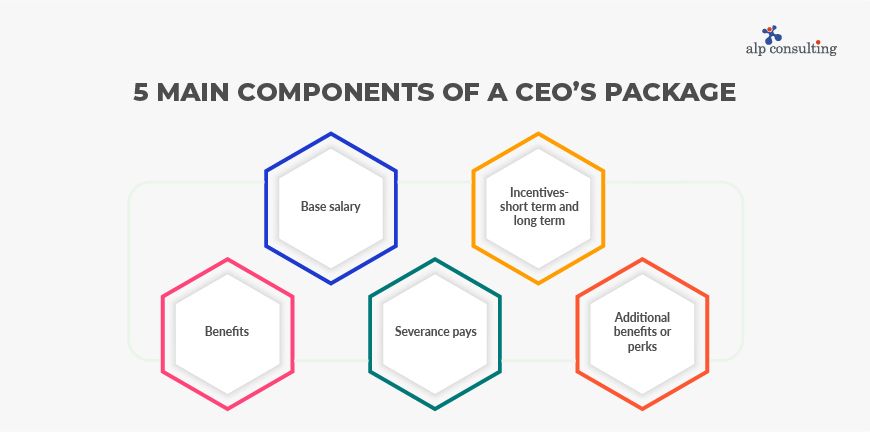
Difference between HRD and HRM
03/06/2024
Benefits of Using Retained Executive Search in Recruiting
05/06/2024- What is CEO Compensation?
- Why is it important to create a fair CEO compensation package?
- How is CEO Pay Determined?
- What are the components a CEO’s package must include?
- How Should Companies Balance Fixed vs Performance-Based Pay?
- What Are the Latest Trends in CEO Compensation?
- What Are the Legal and Governance Guidelines for CEO Pay in India?
- How does CEO compensation impact company culture and employee morale?
- What are the Examples of CEO Pay Packages?
- Should a CEO be compensated based on performance?
- Conclusion
- Frequently Asked Questions (FAQs)
One of the topmost positions you can secure as a professional working his way up the career ladder is that of a CEO. A CEO’s position while quite challenging is also the most rewarding one. When you hear CEO, you automatically assume that they are handsomely compensated. Making sense of the numbers that companies are paying their top brass, is a little hard. An organization mostly bases an executive’s compensation on well-established policies and good governance that align with the corporation’s overall goals.
Although around 73% of people say that the CEO compensation is too high, the reality is somewhat different. Determining how much a CEO deserves to be compensated can be extremely complicated.
Of course, like regular employees, CEOs’ get an annual salary, but they are also entitled to other rewards and benefits depending on certain parameters like the company growth, performance, shareholder value etc. So, the exact compensation of a CEO is a total package of all the other rewards and benefits, not just the salary.
What is CEO Compensation?
A CEO’s compensation is the total package the CEO earns, including a fixed salary, performance-based bonuses, paid vacations and other benefits. A CEO’s salary is determined by an executive compensation committee assembled by the board of directors of the company.
Why is it important to create a fair CEO compensation package?
It’s important to create a fair compensation package for a CEO in all companies, but especially for publicly traded companies, because they must report how much the CEO earns. Boards have it tough, between offering a good compensation to either retain or attract a new CEO and creating a package that the shareholders are happy with. Getting this right is no easy feat.
How is CEO Pay Determined?
CEO pay is determined by the board of directors or a compensation committee. Some of the key factors that influence the pay of CEO.
- The board of directors or a committee that is solely responsible for determining the compensation of a CEO
- Profitability is being focused on rather than just revenue growth. And this is reflected in bonus and equity structures
- Long-term incentives are a must if organizations are looking for better performance, business-wise and higher shareholder value.
- Pay depends on how big the company is, in terms of revenue and assets. Big companies naturally pay more. Industry-specific benchmarks also play a role.
- Compensation consultants help companies set pay levels by offering the right data or expert advice.
- Shareholder influence and regulatory guidelines also play a role in how CEO pay is structured.
What are the components a CEO’s package must include?
To understand how much and how to pay a CEO’s salary, you must know the mandatory components the package must include.

There are 5 main components of a CEO’s package. They are-
- Base salary
- Incentives- short term and long term
- Benefits
- Severance pays
- Additional benefits
1. Base salary
Depending on the type of industry, the CEO’s experience and other factors, a CEO’s salary can vary substantially. To decide the base salary of a CEO, the board appoints an executive compensation committee.
Often, CEOs receive a base salary over $1 million. Depending on how well or poorly the company does, a CEO is rewarded. But in general, it’s a given that if the company is paying larger base salaries, the size of incentives decreases, making it harder for executives to stay motivated and make smart decisions.
2. Incentives- Short term and long term
There are two types of incentives a CEO is entitled to, short term and long term.
Short term incentives
To gauge a CEO’s potential, as part of strategic planning, the board of directors set short term goals to achieve. These goals are set based on varied factors, type of business and other conditions. They could be revenue based or operations based like-
- Expansion into new markets
- Development of new products
- Meeting product deadlines
- Increase profits or revenue
Most boards divide the base compensation into two parts, the first is the normal payout made as a salary for expected performance and the second part is a certain extra payout or incentive as you call it made for performance exceeding expectations.
Long term incentives
Long term incentives, just as the name suggests, are rewards given for a CEO’s performance over more than a year, mostly in a three-to-five-year period. In 2021, long terms incentives and payouts accounted for 72% of total CEO pay. long term incentives are usually provided in the form of stock-based compensation by companies. Some forms are-
- Stock options
- Performance vested stock
- Stocks
Long term incentives are usually based on projected future events returns to shareholders, return on assets etc.
3. Benefits
CEO benefits are similar to those of regular employees within the company. Benefits for CEO’s could include
- Medical insurance
- Unemployment insurance
- Paid vacation
- Health insurance
- Life insurance
- Workers’ compensation
- Others
4. Severance pay
A severance pay is something that is provided to CEOs in case of voluntary or involuntary termination. Of course, a CEO’s top priority should be the company and its growth but if there is a merger or an acquisition, it could threaten the CEO’s position, when the new administration takes over. That being said, a severance pay does not just benefit a CEO but also an organization. How?
- In recruiting and retaining talented CEO
- Can interest a potential CEO candidate leaving a long-time employer due to fear of the plan not working out.
For a CEO a severance pay is beneficial when-
- They lose their jobs due to a merger
- Do not have to worry about suddenly put in the dark and losing their source of income
5. Additional benefits or perks
There are some additional benefits only the CEOs are entitled to. And these benefits are provided to them during their need or when they demand for it.
- Special parking space
- Security for executives at home or work
- Private vehicles with driver
- Others
How Should Companies Balance Fixed vs Performance-Based Pay?
To balance fixed pay vs performance-based pay:
• Combine the base salary with a variable pay component like bonuses, commissions, profit sharing, etc, to create a balance between the two
• Specific, measurable, achievable, relevant, and time-bound (SMART) goals are to be defined.
• A common pay structure must be defined, but must have room for taking into account performance levels like meeting expectations, exceeding expectations, etc, to maintain transparency.
• When an individual is due for promotion and they are eligible for a pay increase, this amount should be significant to avoid making employees feel confused or as if they are underpaid.
• Along with the variable pay, make sure to offer individuals other rewards like training, recognition programs, etc. This is one of the ways other than monetary benefits to enhance motivation.
• Research industry benchmarks and make sure you either meet or cross these values while compensating employees.
What Are the Latest Trends in CEO Compensation?
To compensate CEOs fairly, there are several changes in pay trends. These trends are based on the change in mindset of both organizations and executives.
1. Higher emphasis on Performance-based compensation
Performance-based pay is based on factors like the growth in revenue due to their efforts, profits that they bring, and sustainability goals they achieve. This is done to ensure alignment between executive pay and organizational performance.
2. Higher focus on ESG (Environmental, Social, and Governance)
CEOs who are more inclined towards achieving ESG goals, either by increasing diversity, inclusion efforts, following ethical business practices, etc, are being prioritized.
3. Rise in equity-based compensation
Stock options, restricted stock have always been a crucial part of executive pay. This part of the compensation ensures that companies can focus on long-term value addition.
4. Customization of Compensation Packages
This customization in the package can be in the form of personalized retirement plans, flexible work arrangements. This ensures that the specific needs of executives are met and motivates them to work longer periods.
5. Impact of remote work on executive compensation
With more executives working from home or in hybrid arrangements, companies are reevaluating their pay structures. This has led to adjustments in base salaries, while in others, it has prompted a rethinking of benefits and perks.
What Are the Legal and Governance Guidelines for CEO Pay in India?
The legal and governance guidelines as to how much a CEO must be paid in India are set by the Companies Act, 2013, and SEBI Regulations, 2015. Here are some of the key guidelines
- Total compensation for all executives, including managing directors, directors, and managers, should not exceed 11% of the company’s net profits. A single manager or director cannot get more than 5% of the net profits.
- Shareholders’ approval is required if, under any circumstances, the pay limit exceeds the said amount, before paying the directors or other members of the group.
- In case there are lesser profits made by the company, according to Schedule V of the Act, the directors can be paid more.
- The compensation given to the executives must be disclosed in a detailed report according to SEBI regulations.
- SEBI regulations ensure that there is complete transparency and accountability regarding the compensation made to the executive.
How does CEO compensation impact company culture and employee morale?
High executive compensation can shape a company’s culture by influencing how employees perceive fairness and equality within the organization. Studies show that when executives are paid a lot more when compared to the average worker, it can demotivate employees and result in them losing trust in the organization and its fairness towards employees. This disparity in compensation can lead to a lack of trust within the workplace, ultimately impacting the overall company culture.
What are the Examples of CEO Pay Packages?
The pay package of a CEO includes base salary, benefits, bonuses, and other long-term incentives that are:
- Base salary- This is a fixed annual amount paid to the CEO to ensure stability. For example, the average base salary in India can be around 20-22 lakhs per annum, while in the US, it may exceed USD 400,000 (3.6 crore).
- Performance Bonus- This is variable pay that is provided upon achieving milestones or exceptional performance that leads to growth in revenue. Bonuses can range from 50-150% depending on the size of the company.
- Long-term incentives (LTI)- This includes stock options, performance shares that are aligned with long-term company performance. This comprises 70% of the total compensation of a CEO in big companies.
Other benefits include retirement plans, flexible work arrangements, and other allowances.
Should a CEO be compensated based on performance?
A CEO is not just responsible for overseeing the entire organization’s operations, but research says that they are also responsible for 40% of company performance. Tying a CEO’s compensation to performance is not only in the best interest of the company but is also the right thing to do.
Conclusion
Determining how much to pay a CEO is a multifaceted decision that requires balancing numerous factors to align the CEO’s compensation with the company’s goals, performance, and industry standards. By carefully considering these factors, companies can establish a CEO compensation plan that attracts and retains the right talent, motivates exceptional performance, and aligns the CEO’s interests with those of the shareholders and the long-term health of the organization.
How Can ALP Consulting Help Companies Design Competitive CEO Pay Structures?
ALP Consulting can help companies design competitive CEO pay structures through a specialized approach to executive search and compensation strategy. By combining industry-specific knowledge with expertise in performance-based incentives and market benchmarking, ALP can craft packages that attract and retain top-tier leadership while aligning executive interests with business goals.
Frequently Asked Questions (FAQs)
1. How is a CEO’s total compensation calculated?
A CEO’s total compensation is calculated by the board of directors or a dedicated committee as a package including base salary, variable pay, bonuses, stock options, and more.
2. What is a good pay-to-performance ratio?
As per the average for the market, many value investors would refer to 20 to 25 as the average P/E ratio range. The lower the P/E ratio a company has, the better an investment the metric is saying it is.
3. Why do CEO salaries differ across industries?
CEO salaries differ across industries due to factors like industry competition, company size, and the specific skills required. Depending on these, the demand for executives in high-pressure sectors can be significantly higher.
4. What is the difference between short-term and long-term incentives?
Short-term incentives boost performance quickly, like bonuses, while long-term incentives sustain commitment, like stock options, over a longer period of time.
5. How can companies ensure CEO pay transparency?
By openly sharing how compensation decisions are made, including principles and salary ranges, to enable pay equity and clarity, pay transparency can be achieved in organizations.
Contact Us For Business Enquiry

Rajkumar Shanmugam
Rajkumar Shanmugam is the Head of HR at ALP Consulting, bringing over 19 years of comprehensive HR leadership experience across India and international markets. His expertise spans talent acquisition, employee relations, performance management, compliance, and HR transformation. Rajkumar has a proven track record of driving people-centric initiatives, enhancing workplace culture, and aligning HR strategy with business goals. With extensive experience in US staffing operations and global mobility, he continues to lead organizational excellence through innovation and employee engagement.




